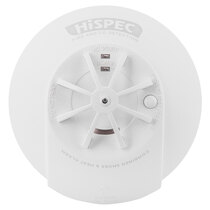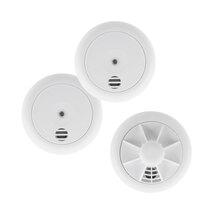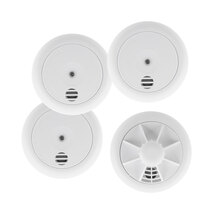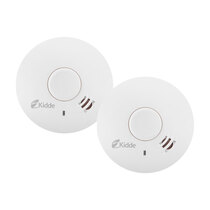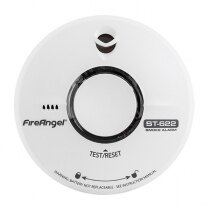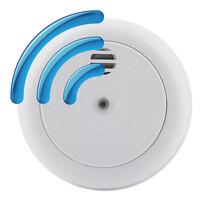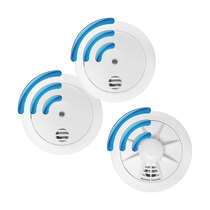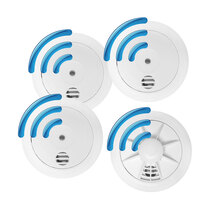-
Contact
Sales & Customer Service
0800 612 6537 support@safelincs.co.uk Live ChatDelivery Enquiries
0800 077 6149 - Resources
Fire & Safety Solutions
CALL OUR TEAM NOW 0800 612 6537
Also FREE from UK mobiles
FREE Delivery
on marked products
Live Chat - Online
Instant help & Advice
Trade Discounts
and exclusive pricing
0% Credit Available
Open an account now
5 Star Customer Feedback
Optical Smoke Alarms
Advanced detection technology responds swiftly to the fires that pose the greatest risk to your family. A photoelectric smoke alarm detects smouldering fires faster than traditional systems, providing crucial early warning when seconds matter most. Photoelectric Technology Explained Optical sensors use light beam interruption to detect smoke particles. When smoke enters the detection chamber, it scatters infrared light onto a photocell, triggering the alarm. This method excels at identifying larger smoke particles from slow-burning fires. Smouldering fires produce dense smoke long before flames appear. Furniture, carpets, and bedding create these dangerous conditions that can fill rooms with toxic gases while occupants sleep. Less prone to false alarms compared to other detection methods, optical alarms are less likely to activate from cooking fumes or shower steam. Modern optical sensors incorporate advanced algorithms that distinguish between genuine fire conditions and harmless environmental factors. This intelligent processing reduces nuisance activations and maintains high sensitivity to real threats. Optimal Application Areas Living rooms benefit from optical detection due to soft furnishings that create smouldering fire risks. Sofas, curtains, and carpets can burn for extended periods before producing visible flames, generating dangerous smoke concentrations. Bedrooms require optical alarms positioned away from windows and air vents to prevent false alarms from drafts. Central ceiling placement provides optimal smoke detection coverage throughout the sleeping area. Hallways and escape routes need immediate fire notification to ensure safe evacuation. Optical alarms positioned in these critical pathways provide early warning that allows occupants to exit before smoke obscures visibility. Office spaces containing paper, electronics, and furnishings benefit from optical detection. These materials typically produce smouldering fires that generate substantial smoke before temperature rises significantly. Product Selection The Kidde 29HD offers proven reliability with optical sensor technology. This unit combines affordability with essential features including low battery warnings and test button functionality. Sealed battery options eliminate maintenance concerns for property managers. The UltraFire ULLS10 provides 10-year operation without battery replacement, ideal for rental properties or hard-to-reach locations. Interconnected optical alarms create comprehensive protection networks. When combined with heat detection systems, these sensors provide complete fire safety coverage tailored to each room's specific risks. Professional-grade units meet commercial installation requirements and offer residential applications enhanced features. These systems often include remote testing capabilities and diagnostic functions. Our optical alarm range encompasses solutions for every property type and budget. Expert guidance helps you select appropriate models for your specific application requirements. For installation guidance and positioning advice, consult our professional installation guides. Proper placement maximises detection effectiveness and minimises false alarm potential. Invest in proven detection technology that prioritises your family's safety. Explore our photoelectric smoke alarm selection and discover the protection advantages of modern optical sensing systems. Frequently Asked Questions (FAQs) Why are optical smoke alarms better than ionisation detectors? An optical smoke alarm is superior to ionisation models because it responds faster to smouldering fires that produce large smoke particles, while being less prone to false alarms from cooking. Where should photoelectric smoke alarms be installed? Photoelectric smoke alarms work best in bedrooms, living rooms, and hallways where smouldering fires are most likely, positioned centrally on ceilings away from air vents and windows. Do optical smoke detectors work in dusty environments? Optical smoke detectors can experience reduced sensitivity in very dusty conditions, so regular cleaning and maintenance are important to ensure proper operation in challenging environments. How often should optical smoke alarms be tested? Testing optical smoke alarms monthly by pressing the test button is recommended to ensure proper operation, with additional checks using smoke detector test aerosols annually.
Read more about optical smoke alarms...
Mains Radio-Interlinked Optical Smoke Alarm with Sealed Longlife Back-up Battery - FireAngel Pro Connected FP1640W2-R
- Power: 230V mains powered with lifetime back-up battery
- Back-up Battery: Built-in, lasts the lifetime of your alarm – GUARANTEED
- Warranty: 5 year warranty
- Thermally enhanced optical sensor (Thermoptek)
- Can interlink with up to 50 Wi-Safe 2 compatible devices
- Range of up to 35m in buildings
- Suitable for BS 5839-6: 2019 Grade D1 installations
- Kitemarked to EN 14604: 2005
- Also suitable for both the Welsh and Scottish 2022 legislation
Mains Radio-Interlinked Optical Smoke Alarm with Self-Charging 10 Year Back-up Battery - Aico Ei3016RF
- Power: 230V mains powered with back-up battery
- Backup Battery: Self-charging battery
- Warranty: 5 year warranty
- Supplied with Ei3000MRF SmartLINK module
- Radio-interlink with up to 12 devices
- Extract real time data to their smart phone
- CE and Kitemarked to BS EN 14604: 2005
- Also suitable for both the Welsh and Scottish 2022 legislation
Mains Radio-Interlinked Combined Smoke and Heat Alarm with Self-Charging 10 Year Back-up Battery - Aico Ei3024RF
- Power: 230V mains powered with back-up battery
- Backup Battery: Self-charging battery
- Warranty: 5 year warranty
- Combined alarm: both an optical smoke, and heat sensor
- Hybrid interlinking with up to 12 compatible devices
- AudioLINK - extract real time data to your smart phone
- Kitemarked to BS EN 14604: 2005 (smoke)
- Kitemarked to BS 5446-2: 2003 (heat)
- Also suitable for both the Welsh and Scottish 2022 legislation
Mains Powered Smoke & Heat Alarm with Rechargeable Lithium Battery Backup - Hispec RF10-PRO
- Power: 230V mains powered with lithium back-up battery
- Back-up Battery: Rechargeable lithium battery
- Warranty: 5 year manufacturer's warranty
- Multi-sensor alarm containing both a smoke and heat sensor
- Radio-interlink up to 20 compatible alarms
- Kitemarked to BS EN 14604: 2005 (smoke)
- Kitemarked to BS 5446-2: 2003 (heat)
- Also suitable for both the Welsh and Scottish 2022 legislation
10 Year Sealed Battery 2 Smoke Alarms & 1 Heat Alarm Kit - UltraFire ULL10
- FREE delivery
- Battery: 10 year sealed lithium battery
- Warranty: 10 year manufacturer's warranty
- Large combined test and silence button
- 2 x optical smoke alarms and 1 x heat alarm included
- Suitable for BS 5839-6: 2019 Grade F1 installations
10 Year Sealed Battery 3 Smoke Alarms & 1 Heat Alarm Kit - UltraFire ULL10
- FREE delivery
- Battery: 10 year sealed lithium battery
- Warranty: 10 year manufacturer's warranty
- Large combined test and silence button
- 3 x optical smoke alarms and 1 x heat alarm included
- Suitable for BS 5839-6: 2019 Grade F1 installations
10 Year Longlife Battery Optical Smoke Alarm Twin Pack - Kidde 10Y29
- FREE delivery
- Battery: Built-in, lasts the lifetime of your alarm - GUARANTEED
- Warranty: 10 year warranty
- Features test and hush buttons
- Low Volume Test feature
- 2 x KE10Y29 smoke alarms
- Suitable for BS 5839-6: 2019 (Grade F1 installations)
- Kitemarked to BS EN 14604: 2005
Battery Optical Smoke Alarm - UltraFire UBS1 Twin Pack
- Battery: 9V alkaline battery (included)
- Warranty: 10 year warranty
- Large test and hush button
- High performance optical sensor
- 2 x optical smoke alarms included
- Suitable for BS 5839-6: 2019 Grade F2 installations
- Certified to BS EN 14604: 2005
Radio-Interlinked 3 Smoke Alarms and Heat Alarm Kit - UltraFire
- Powered with AA alkaline batteries
- Warranty: 10 years
- Large test & hush button
- Wirelessly interlink up to 50 compatible devices
- Includes 3 x optical smoke alarms and 1 x heat alarm
- Suitable for BS 5839-6: 2019 Grade F2 installations
10 Year Thermally Enhanced Optical Smoke Alarm (Thermoptek) - FireAngel ST-622
- Battery: Built-in, lasts the lifetime of your alarm
- Warranty: 5 year warranty
- Combined smoke and heat alarm (Thermoptek)
- Test, hush and Sleep Easy™ feature
- Optical sensor less prone to false alarms
- Suitable for BS 5839-6: 2019 (Grade F1 installations)
- Kitemarked to BS EN 14604:2005
Thermally Enhanced Optical Smoke Alarm (Thermoptek) - ST622 Twin Pack
- Battery: Built-in, lasts the lifetime of your alarm
- Warranty: 5 year warranty
- 2 x optical smoke alarms included
- Test, hush and Sleep Easy™ feature
- Thermoptek sensor less prone to false alarms
- Suitable for BS 5839-6: 2019 (Grade F1 installations)
- Kitemarked to BS EN 14604:2005
Radio-Interlinked 10 Year Sealed Battery Optical Smoke Alarm - UltraFire ULLS10RF
Supporting wireless interlink with up to 15 total alarms to cover the whole house, the UltraFire ULLS10RF optical smoke alarm features a sealed 10 year battery and 10 year manufacturer's warranty.
- Battery: 10 year sealed lithium battery
- Warranty: 10 year manufacturer's warranty
- Optical smoke sensor suitable for hallways, landings, living rooms, and bedrooms
- Wireless interlink up to 15 total alarms
Radio-Interlinked 10 Year Sealed Battery 2 Smoke Alarms & 1 Heat Alarm Kit - UltraFire ULL10RF
- FREE delivery
- Battery: 10 year sealed lithium battey
- Warranty: 10 year manufacturer's warranty
- Wirelessly interlink up to 15 UltraFire ULL10RF devices
- 2 x optical smoke alarms and 1 x heat alarm included
- Suitable for BS 5839-6: 2019 Grade F1 installations
- Compliant with Scottish 2022 and Northern Ireland Landlord 2024 legislation
Radio-Interlinked 10 Year Sealed Battery 3 Smoke Alarms and 1 Heat Alarm Kit - UltraFire ULL10RF Series
- FREE delivery
- Battery: 10 year sealed lithium battey
- Warranty: 10 year manufacturer's warranty
- Wirelessly interlink up to 15 Ultrafire ULL10RF devices
- 3 x optical smoke alarms and 1 x heat alarm included
- Suitable for BS 5839-6: 2019 Grade F1 installations
- Compliant with Scottish 2022 and Northern Ireland Landlord 2024 legislation
Page 3 (54 of 54 Products)
What is an Optical Smoke Detector?
Optical smoke alarms, also known as photo-electric smoke alarms, are the most common type of sensor seen in households. This sensor type is suitable for rooms such as living rooms, bedrooms, and hallways. These are considerably safer than the previous sensor type, ionisation, as they do not contain any radioactive material. The advanced optical smoke sensor, means that they are less prone to false alarms caused by cooking fumes and steam, making them suitable for being installed near, but never in kitchens or bathrooms.
How do they work?
Optical smoke alarms work by 'seeing' smoke produced by slow smouldering fires, often a result of soft furnishings burning. The alarm works by using the light scatter principle, this is where a pulsating infrared LED operates within the alarm sensor, pulsing every 10 seconds to check for smoke particles. Once smoke particles are detected within the optical chamber, it activates the sounder alerting occupants to the fire. For further visual information on how optical smoke alarms work, please see our handy guide page.
Where Should I fit an Optical Smoke Alarm?
Optical smoke alarms are best situated in rooms where soft furnishings are, such as bedrooms, living rooms, hallways, and landings. Within these rooms, it is recommended by the manufacturer that the alarm is installed on the ceiling, however there are exceptions where smoke alarms can be installed on the wall. The best installation locations are specified in the user manual supplied with any alarm.
How to change the battery in an optical smoke alarm
Changing the battery in an optical smoke alarm all depends on how the alarm is powered. Some optical smoke alarms are powered by a sealed lithium battery and do not require to be changed for the entirety of their 10-year lifespan. After the 10-years, it is strongly recommended that the alarm is replaced in full, as the sensor deteriorates over time, making it less effective in detecting a fire and more likely to false alarm due to contamination.
Other optical smoke alarms are powered by a replaceable alkaline batteries, which through typical use, should be replaced every one to two years. For most of these types of replaceable batteries, the battery compartment can be found on the back of the alarm when removed from the base plate. When replacing a battery, it is key to remember that the replacement battery is one recommended by the manufacturer. Use of batteries which are not recommended, could result in the alarm not functioning as it should, or even fail to power the alarm at all.
The location of your alarm, or more specifically the temperature of the room, can affect the battery life in a smoke alarm. If the temperature is too cold, this affects the battery performance, and may reduce its efficiency.
Compare (0)
Reset























